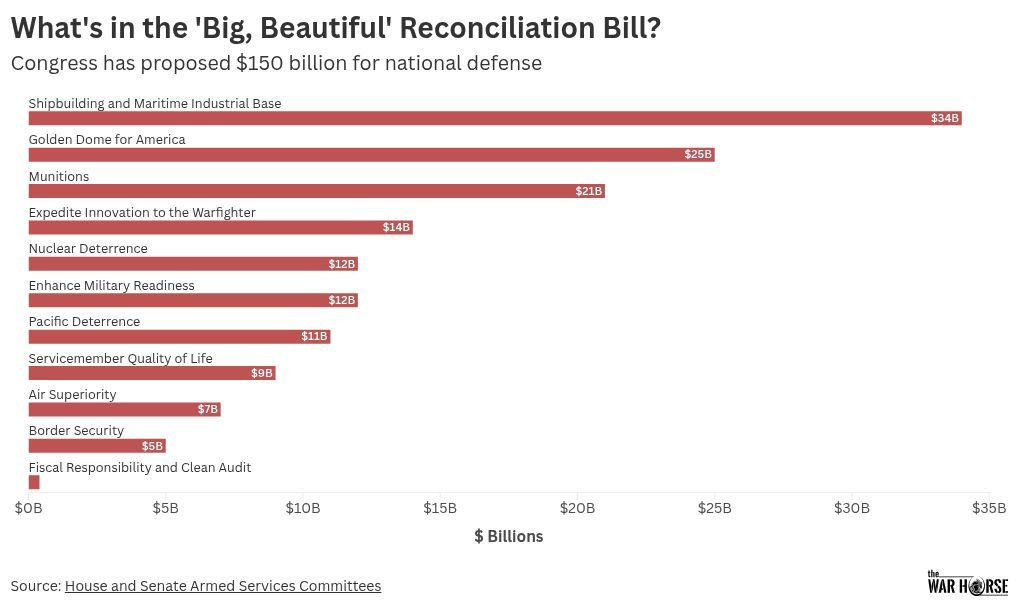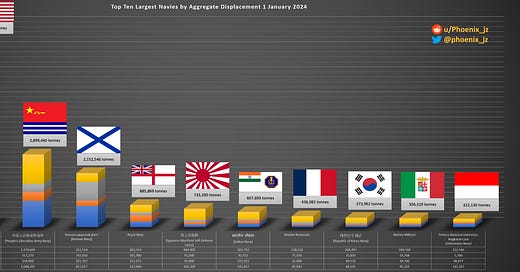Building Slow, Falling Behind: The Crisis in American Shipbuilding
From Aging Fleets to Delayed Deliveries, Assessing Our Maritime Vulnerabilities
Good morning,
When Congress passed the 'Big, Beautiful Bill’ last week, it included $150B in reconciliation spending for the DoD. The single greatest defense-related item in the bill was $32.6B for shipbuilding.

This is a great opportunity to discuss shipbuilding.
Why is shipbuilding important?
Oceans cover about 70% of the earth’s surface.
Maritime transport represents 80% of global, international trade in goods.
The United States shares land borders with only two countries, meaning that anything else we want to trade internationally must go by sea or air.
Military shipbuilding is important for:
Safeguarding our shores from enemies
Protecting our economic interests in shipping
Projecting the force globally for numerous reasons including humanitarian, peacekeeping, and war.
What’s wrong with American shipbuilding?
America produces five or fewer large commercial vessels per year.
Less than 1% of ocean-going large vessels are of American provenance.
America’s shipbuilding capacity is <0.5% of China’s.
Shipping (like shipbuilding) is dominated by non-American companies.
Depending on how we count, the United States has the largest navy fleet in the world. Or, China does. By number of vessels, China has almost twice as many as the United States. But many of those are smaller, patrol-craft type vessels. The United States trumps on tonnage, with almost 3x the displacement of China.
For example, the United States has 11 aircraft carriers to China’s 3 (counting the Fujian which is currently under sea trials and is expected to formally enter service later this year).
But, changes in technology and warfighting calls into question if having fewer, high-tonnage ships is as prudent as it once was and if it’s still as viable as more, smaller ships.
To further complicate things, America’s navy is aging. China’s navy is an average of 5-6 years younger.
Now, China has demonstrated recently its blue water capabilities, accelerating its status as a global power capable of force projection far beyond its territorial waters.
Combining its growing size and more importantly its shipbuilding capacity allows China to have significant advantage in traditional naval warfare—should it ever come to that—over the United States.
Is that all?
One more thing on how American shipbuilding is lagging behind China.
Speed of shipbuilding.
China laid the keel of the Fujian four months prior to the United States laying the keel for the USS John F. Kennedy (CVN-79). Admittedly the Kennedy is a larger ship, but China began sea trials of their ship last year. The Kennedy, which was originally scheduled for delivery to the Navy this month, won’t be completed for at least another two years.
The United States has over a century of experience, having built (to completion) more than 65 aircraft carriers. China built their first carrier, faster than we could build our 68th.
We haven’t always been so slow. We built the USS Enterprise (CV-6) in less than four years. That was in the mid 1930s, when the Defense Industrial Base was not fully ramped up. In all honesty, the DIB at that time was fairly comparable to today. On a wartime footing, we built the USS Yorktown (CV-9) in 14 months!
To make matters worse, the Kennedy was scheduled for completion this month. While rumors appeared in April that it would likely need until 2026, this week it was announced that the ship wouldn’t be completed until 2027.
Not only is the timeline itself egregious, but the failure of project and program management that resulted in a 2 year schedule change in the same month that the product was scheduled for completion is particularly so.
We’ve reached out to the Navy’s PEO Aircraft Carriers, its Industrial Operations, and Newport News Shipyard responsible for building the ship, none have provided comments on the status.
These unacceptably slow builds mean that platforms are obsolete before they’re ever accepted into service.
Are we even building the right things?
This is a multi-billion dollar question.
For nearly a century, aircraft carriers have dominated naval warfare theory.
It has become a nearly sacrosanct precept of naval warfare.
But should it be? Or, has advanced technologies including precision warfare and the ability to find, fix, track, target, and engage increasingly smaller craft at increasingly larger ranges obviated the advantages of the aircraft carrier?
A Gerald Ford-class aircraft carrier (of which the John F. Kennedy is one) costs somewhere around $13.3B and carries around 50x F-35Cs at a cost of $100M/aircraft. Sink one of those and down the drain goes ~$20B and more importantly up to 5,000 Sailors.
Or should the Navy scale back its acquisition of these large systems and reprogram some of that money to smaller, more agile, craft that can launch and recover autonomous systems, missiles, and other weapons while minimizing crew requirements?
The Navy needs to put in some hard thought on the future of warfare and how it will adapt. It needs to way the trajectories of technology with the various risks of its options.
Alright, on to the news.
News Headlines
Israeli officials admit that some of Iran's enriched uranium survived U.S. strikes (NYT)
White House launches fresh attack on Fed's J. Pow, as Trump seeks new chairman willing to return to ZIRP (CNN)
SecState Rubio must make the case why Asia countries worried about Trump's tariffs should align with U.S. instead of Beijing (NYT)
Stocks slide as Trump returns to tariff threats (WSJ)
Former VP Pence: isolationists losing sway with Trump (CNN)
Defense & Dual-Use Technologies
Trump taps former AWS exec for senior role in Pentagon’s research and engineering directorate (DS)
DARPA cancels cargo seaplane program (DN)
DoD takes largest minority stake in rare earth mining company (DO)
The Army is hiding HIMARS rockets into shipping containers (TWZ)
Army tests robotic coyotes to defend fighter jets (MT)
With push to 3d print drones, Army examines battlefield calculations (BD)
Navy cancels submarine torpedo-tube launched underwater drone (TWZ)
Cyber Command seeks $5M for data standards project in FY26 budget (DS)
Threat Tech
Chinese warship-laser dazzles German surveillance plane in Red Sea (TWZ)
China seeks to hit the Pentagon by imposing rare earth export controls (DO)
U.S. to ban Chinese purchase of farmland, citing NatSec concerns (WP)
Iranian strikes rose to 16% successful penetration of Israeli defenses, struck at least 5 military bases (TOI)
Israel says Iran could reach enriched uranium at a nuclear site hit by U.S. (AP)
Russia strikes Ukraine with 700 drones in largest ever drone attack (AP)
Foreign Defense Tech
E.U. Presidency calls for rearmament within 5 years (AP)
Europe is on an American weapons buying spree (DJ)
NATO testing Baltic Sea drones to track Russian warships, freighters (DN)
France asks Future Combat Air System partners to 'rethink' work share on fighter project (DN)
France, UK join forces in step toward European nuclear deterrent (DN)
U.S. wants S. Korea to join efforts to counter China in shipbuilding (RT)
European allies step-up plans for future Ukraine stabilization force, with U.S. attending meeting (MIL)
Defense Industry
DARPA picks Bell Textron for new runwayless drone X-plane (ASF)
Boeing delivered the most jets in 18 months ()
Helsing is building an underwater drone factory in Plymouth, UK (DJ)
HII sees two year delay for next Ford-class aircraft carrier, originally scheduled for delivery this month (NI)
Autonomous Systems
President Trump issued an executive order last month on 'unleashing America's drone dominance' (DS)
SecDef Hegseth directs extensive reforms to Pentagon drone-buying practices and recognizes smaller drones as 'expendable' in huge leap for readiness for drone combat (DN)
RTX demonstrates autonomous capabilities of its Barracuda mine neutralizer (SPM)
Finance & Deal Flow
Funds
a16z exits Delaware, encourages startups to follow it to Nevada (NYT)
National security-focused VC America's Frontier Fund plans to raise $315M for a debut fund (BI)
The Veteran Fund is raising a $50M Fund II for investments into dual-use startups (PB)
VC
Hypersonic weapons startup Castelion raised a $350M Series B at a unicorn valuation led by Lightspeed Venture Partners and Altimeter Capital (TC)
XPANCEO, a Dubai-based deep tech developing the world's first multifunctional smart contact lens, raised a $250M Series A at a $1.35B valuation led by Opportunity Venture (TFN)
Cambridge Aerospace, a stealth UK startup developing Iron Dome-like defense systems, raised ~$100M in early funding at a targeted $400M valuation (Source Unavailable)
SkyDrive, a Japanese eVTOL aircraft manufacturer, raised an $56M pre-Series D led by MUFG (PU)
German robotics startup Filics raised a $15M round from Sandwater, Alven, F-LOG Ventures, Amazon, and more (SC)
Steady Energy raised $37.4M in funding led by Tesi and LocalTapiola to build a full-scale, non-nuclear pilot plant in Helsinki as it prepares for wider commercialization of small, modular nuclear reactors (BB)
Ionic Mineral Technologies, a vertically integrated US producer of advanced materials for the energy, defense, and technology sectors, raised a $29M Series B (BW)
Helical Fusion raised a $15.6M Series A led by Toyoda Gosei to advance its stellarator magnetic confinement approach to fusion energy (BW)
Nautica Technologies raised a $3.97M round led by b2venture to fund the commercialization of its underwater robots used for maintenance of ship hulls (EUS)
PE / M&A / Exits / Other
Aerospace and defense tech provider Leonardo bid $1.9B for truck manufacturer Iveco Group's defense unit, the lowest among offers (RT)
Exciting Opportunities
DIU is seeking low cost undersea effectors (DIU)
The Navy will host a classified industry day to discuss its Liberator and Hunter unmanned maritime programs (SAM)
Editor's Picks
U.S. Navy commander Adam Stein offers four critical steps for new entrants into the Defense Industrial Base.
The Institute for the Study of War (ISW) explains how China's and Russia's fates are intertwined in the war in Ukraine.
Lighter Side
Keep Building,
BOF







This isn’t a navy problem. It’s an American problem. We’ve chosen to focus our industry and money elsewhere. Plenty of that happened under the rubric of the “peace dividend.” We put a lot of money into other programs. We went through “BRAC.” Les Aspin and Ash Carter told industry to consolidate during the “Last Supper.” Now, we see that we have to reverse course. So, the Naval force needs all the help it can get from private equity, infrastructure and heavy industry, and our elected representatives - in the way of policy, statute, and regulation/deregulation - and MONEY.
Good to see more investment into shipbuilding. One thing that’s often is overlooked is that the Chinese require every commercial ship to be built to military standards, so that if needed they can be retrofitted to serve military purposes. Obviously these aren’t true warships, but could still be significant in a conflict. It’s also a great example of dual-use tech on a large scale. Maybe we should be taking notes. Looks like things are moving in the right direction though. Thanks for putting this together.